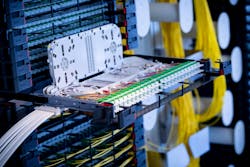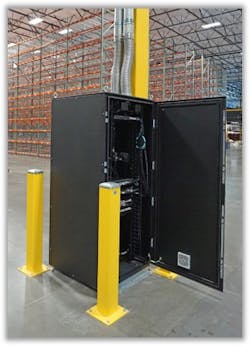Protecting cabling and equipment from the hyperscale to the edge
By Patrick McLaughlin
In any type of computing environment, the housing, protection and management of network connections is essential for uptime and performance. The methods for providing that protection and management, as well as the products and technologies for doing so, can vary significantly depending on the computing environment in which they will reside. This article will look at options for cabling and network-equipment housing, protection, and management in different environments.
“Lately the growth of the Internet of Things (IoT) has been pushing telecom, data and computing services away from centralized locations like the telecommunication room (TR) to the outer edges of the network and closer to end users to minimize latency,” explained David Richards, product manager of open systems at Chatsworth Products Inc. (CPI). “These locations include manufacturing floors, warehouses, and multibuilding sites, such as school campuses, which may not have a dedicated room available for the network.”
Richards made this explanation in an article we published in our August 2019 issue, titled “Preparing for the edge? Your telecom room needs a makeover.” Among the insights Richards offered in that article are that larger and heavier equipment requires new rack designs, cable and pathway management has become increasingly important, and making the most of limited floor space is essential in many environments.
In December, two of Richards’s colleagues at CPI—senior product manager for cabinets and thermal solutions Duke Robertson, and senior product manager for industrial solutions Sam Rodriguez—delved deep into these and other topics in a web seminar we hosted. In the seminar, titled “Are you on the right path(way) to better edge network protection?” Robertson and Rodriguez emphasized that there are five pillars of a successful edge deployment: 1) environmental, 2) security, 3) equipment and cabling, 4) thermal management, and 5) monitoring.
Examining environments
“Harsh weather conditions, such as heat, snow, humidity, precipitation and environments with high salt content require equipment to have higher levels of protection,” Rodriguez said. “Protecting equipment in unique locations requires innovative methods of storage, support and maintenance.”
Traditional enclosures won’t do in such unfriendly environments. Rodriguez explained that enclosures made for industrial environments are designed to isolate the interior of the enclosure from the room environment. They typically contain solid doors, sides, roof and floor, with gaskets used between the frame and all panels for additional protection. Bolt-in side panels are specified with strict distances between each connection, and multiple hinges similarly have strict distances between each. These enclosures have multi-point door latches, and the bottom is either solid or a plinth base.
Rodriguez also pointed out that an industrial enclosure’s frames are designed to seal against panels. These sealing surfaces and gaskets create a gutter that wicks liquids away from the gaskets, channeling water from horizontal to vertical, and minimize dripping when a door is opened. He added that formed-in-place gaskets are ideal, as opposed to foam tape gaskets frequently found in enclosures. Formed-in-place gaskets offer a continuous seal with no gaps, provide low water absorption, have high mechanical strength and tear resistance, and have high tensile strength.
Discussing an industrial enclosure’s top and bottom panels, Rodriguez noted that a solid top protects against falling liquids and dust. All solid-top panels will offer protection from water. Some, depending on their rating, may protect against coolant and oils. These panels vary in the extent to which they protect against dust. Solid bottom panels seal enclosures at the base. Removable panels provide access when that is required. And a solid bottom panel provides a support surface upon which cable-entry grommets can be added when required.CPI’s Robertson described NEMA enclosure ratings as well as Ingress Protection (IP) codes that are commonly used to identify enclosures’ resistance to harsh environments and elements. “Enclosure selection should be based on expected performance,” Robertson said. Those performance requirements may include corrosion resistance, for example, or the ability to withstand damp locations, washdowns, or agents including salt spray.
When discussing NEMA types and IP codes, Robertson explained that an enclosure with a specific NEMA type provides a degree of protection against certain environmental conditions. Those conditions can include falling dirt, falling liquids, dust, lint, oils and coolants, or even temporary or prolonged submersion. IP codes are two digits; the first digit refers to the ingress of solid objects and the second digit refers to the ingress of liquids. Take, for example, the IP-67 rating. The first digit—6—indicates the enclosure is totally protected against dust ingress. The first digit of an IP code can be any digit between 0 and 6; 6 indicates the highest level of protection. The second digit of an IP code can be any digit between 0 and 9 (actually 9k), and again the higher the digit the greater the level of protection. A 7 as the second digit of an IP code indicates protection against short periods of immersion in water. An 8 indicates protection against long, durable periods of immersion in water. And 9k indicates protection against close-range, high-pressure, high-temperature spraydowns.
The other pillars
Following is summary information on how Rodriguez addressed the other four pillars of successful edge deployment.
Physical security—Plan for multiple layers of security, ensuring that only authorized individuals have access to equipment. Additionally, enhanced security ensures data that is produced at the edge remains private.
Equipment and cabling—Penetrations through the enclosure can be a primary cause of enclosure contamination and/or equipment failures. Therefore, penetrations should maintain the enclosure’s protection rating. Grommets available on the market allow cables to enter the enclosure while providing tight seals around cables as well as to the enclosure chassis. Conduit can be used with liquid-tight fittings.
Thermal management—An enclosure’s interior temperature will vary based on ambient conditions, including exposure to sunlight or nearby heat sources, as well as exposure to extreme cold. Sealed enclosures may cause an unacceptable heat rise. Potential remedies include vents, which are suitable for very light loads, or filter fans, which propel cool air into the enclosure. These fans build positive pressure, and must be used in combination with an equal-surface-area exhaust filter. Importantly, filter fans should be mounted in the lower third of the cabinet and the exhaust filter(s) should be near the cabinet’s top. Another option is a cooling/heating unit. With such a unit, a heat pump transfers heat to a higher temperature by refrigeration. Cooling units come into play when the ambient temperature is higher than the target internal temperature.
Remote monitoring—Remote monitoring enables the diagnosis of, and sometimes the remedy for, problems that occur in offsite locations that often are unstaffed. Four levels include: site monitoring and security, site conditions (such as the existence of gates, fences, cameras or other sensors), housing (particularly its accessibility), and door contacts (are they open or closed, locked or unlocked?).
The online seminar, which goes into significantly more detail than the information from which this has been excerpted, will be available for on-demand viewing until June 2020.
Distribution frames
At quite a different point in the spectrum of computing environments, the protection and management of connections and equipment in large-scale data centers is no less important than in edge facilities. For certain connectivity needs in these environments, many opt not to use enclosures at all. In a white paper titled “Prepare for data center growth with a centralized patching field,” Leviton Network Solutions’ senior product manager for fiber solutions, Tony Yuen, compares the use of enclosures to fiber distribution frames. “Typically, centralized patching fields come in the forms of traditional cabinets or an open frame with no active equipment inside,” he explains. “Traditional 19-inch cabinets maintain a consistent look with other cabinets in a data center … However, managing cords and trunks in such a high-density application with traditional rack enclosures can become challenging. There is little room for adequate slack management, and fiber bend radius becomes a concern, especially for trunks entering the cabinet.
“Distribution frame solutions are most often used by carriers in central offices, where tens of thousands of fibers are being managed. However, in recent years, data centers have begun adopting the frames. They are capable of patching thousands of fibers, while designed with cable management to alleviate the challenge of higher densities.”
Leviton’x HDX Fiber Distribution Frame has the ability to patch 3,168 LC fibers, or 15,552 MTP fibers, on a single 2x2-foot data center floor tile. The frame includes vertical and horizontal cable managers that are integrated into the frame. It also includes slack spools and cable clamps for properly routing cords and trunks, as well as patch decks with trays that handle horizontal cord management.
“In contrast, vertical and horizontal cable management solutions for traditional cabinets are sold separately and installed at the job site,” Yuen adds. “Some cabinet manufacturers kit the cable management with the cabinet, but cable management will need to be moved or adjusted horizontally and vertically based on the layout.”
Vendors offering distribution frames that mount inside racks or enclosures similarly herald their efficiency.
R&M offers the PRIME (Professional Interconnect Management Equipment) optical distribution frame (ODF), and says the product set’s modules “enable fast and simple installation in cramped environments as well as at sites with higher fiber density. The tool-free system approach and the high modularity guarantee uncomplicated migration into new and existing network infrastructures.”
Wirewerks designed its NextSTEP Distribution Frame (NSDF) for data centers and colocation facilities. The NSDF is designed to be installed in a 19-inch rack or cabinet, which Wirewerks says is a small footprint by comparison to other frames.
“All fibers remain clearly identifiable and easily accessible,” the company says, adding that these characteristics allow fast and accurate moves/adds/changes. Meanwhile, the NSDF’s modular design provides flexibility and adaptability, as well as scalability for a long lifespan and the ability for a facility to pay-as-it-grows.
Patrick McLaughlin is our chief editor.

